 Hare Bite
Hare Bite
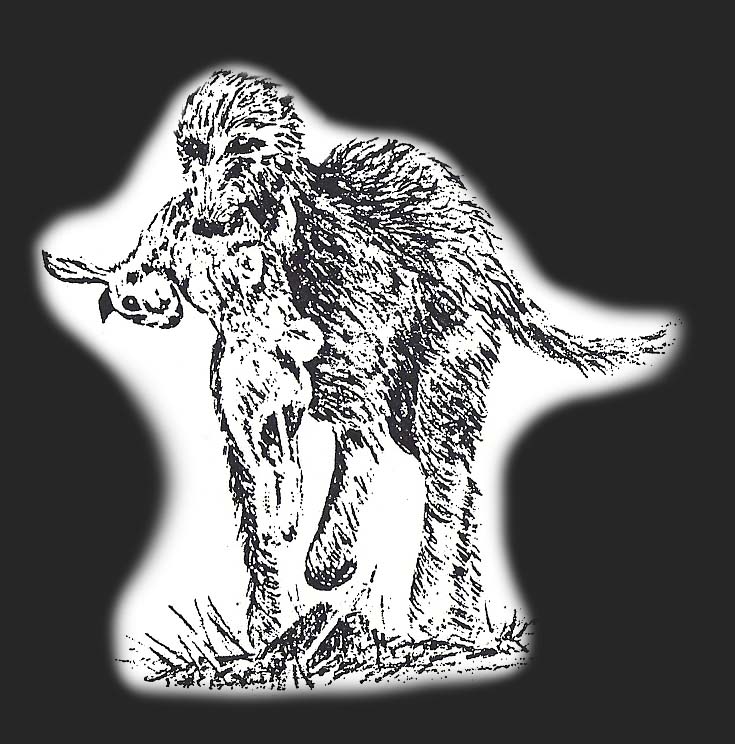 Lure-bite: Deerhounds & lure coursing
Lure-bite: Deerhounds & lure coursing
(Antidotes for Deerhounds and their owners)
Two beliefs that are partly responsible for the small number of lure coursing Deerhounds are,
1: “no preparation is required”, and
2: “the sport is dangerous”.
Which is ironic, because if any sport does have an element of danger the correct care and preparation will help minimize that threat.
The first belief is contrary to current scientific and popularized knowledge on the necessity for human and animal athletes, such as horses and hounds, to be adequately prepared and trained, both physically and mentally. Training which is designed to enable potential, maintain consistent high performance, and which by means of conditioning and experience will afford improved protection from the threat of injury.
The second belief is contrary to a fundamental and guiding principle of lure coursing – which is the creation of athletic sport for sighthounds without the inherent dangers of their original work. It is a prime duty of trial committees to ensure that ground, fields and layout are safe: it follows that it is a prime care of competitors to monitor that duty is properly carried out.
A certain amount of physical and mental training has long been considered beneficial for junior league athletes competing in all field sports. Many of these youngsters have no specific physical ability for any particular sport. Yet society has clearly understood that for them as well as adults in general, regular exercise and the play element of sport are both physically stimulating and intellectually rewarding.
These rewards have certain long-term effects: improved physical skills, the promotion of physical health and a good condition. They also include a particularly familiar short-term effect – the state of well-being.
The lack of regular exercise can have negative effects. In extreme cases it can cause loss of optimum health and physical skill. This is most readily recognizable in selectively bred or “natural” athletes that have a particular adaptation, i.e. fast runners, such as sighthounds.
Sighthounds that have been kept on a leash for their first twelve months of their life, that have been segregated from, or denied the freedom to develop properly by free and regular play with their own sort, will show the consequences of this neglect, called cultural de-conditioning. They may also lack the motivation to run.
Motivation, which is essential to the absolute success of the human athlete, is usually the expectation of winning, which is the reward in itself. Even if the sport has become tedious, and especially when it has become painful.
Motivation, which is absolutely essential to the canine athlete and without which it cannot compete, is solely the reward of the pleasure in competing itself. When it becomes tedious or painful the canine runner, being a free spirit unlike the obedience dog, will usually quit.
Simply put, humans run for rewards, and dogs are rewarded by running.
 The lure is a poor thing in contrast to the original prey of historic coursing hounds. It cannot emulate the excitement of the flight of big game such as red deer , antelope or gazelle. Nor can it offer the same magnetism as the frenzied rush of the hare.
The lure is a poor thing in contrast to the original prey of historic coursing hounds. It cannot emulate the excitement of the flight of big game such as red deer , antelope or gazelle. Nor can it offer the same magnetism as the frenzied rush of the hare.
Therefore it is advisable in the case of those sighthounds such as Deerhounds that lack the single-minded intensity of a breed such as the Whippet, which has been selectively bred for (rag) racing, to imprint them on the lure at the earliest possible age.
A little juvenile lure addiction can work wonders.
Deerhound owners who eventually decide to go lure coursing, for example after a career in the show ring probably with an immature hound, or due to that particularly misguided conception leading to overprotection – after keeping it on a leash for twelve months, as well as those who have quite understandably consistently admonished their hound for chasing other animals, will most likely face a disappointment when they first slip their naïve pet on the lure field. It will either not run or run poorly. It may just possibly run exceedingly well – and then injure itself out of over-enthusiasm.
An inexperienced driver cornering a high performance vehicle with a chassis that is not tuned, on tires that are out of tone, is an accident waiting to happen.
Breed expert Norah Hartley quotes the 19 th century deerstalker Augustus Grimble,
“Young deerhounds are very apt to be rash”
Thereby emphasizing that enthusiasm often placed the inexperienced Deerhound at risk from dangerous situations, especially from potentially aggressive game, until the individual hound learned how to tackle the red deer effectively and safely.
A modern day deerstalker, Kenneth Cassels, with reference to his own Deerhound, agrees,
“I found however that she had to learn how to take deer, instinct alone was not enough”.
All hounds need to be schooled by experience in how to deal with terrain, how best to force and take the game they have been selected for. Grimble’s contemporary, the American hunter van Hummel, puts it this way,
“It is not necessary to train a deerhound for coursing. All that is needed is to show him the game and turn him loose. It is always best to take a puppy out with one or more older dogs, which will take hold of any kind of game, and thus educate the puppy to seize and kill the game he is running”
Van Hummel’s own ‘training’ consisted simply of working the dogs on deer when their frame was strong enough at approximately 12-15 months, but only after physically conditioning them from approximately 9 months of age behind a horse or a horse drawn carriage. Van Hummel assumed, just as contemporary Deerhounders do who course hares, that the stimulus of the sight, the scent, the speed of the chase, the live game itself is usually so electrifying that it will draw any hound into the follow.
Which is not the case with the lure.
Lest the lure turn and ‘bite’ the hound that follows, by unexpectedly wrenching it through illogical turns so hard that it may well sprain its shoulder, then train your Deerhound. Train it to expect the unexpected when it comes across a lure.
Poor layout and unlucky lure operation may occasionally hurt a strong Deerhound; they will almost certainly discourage any sighthound. Mental and physical training will help prevent that.
Kenneth Cassels who was greatly responsible for the UK post-WWII revival of competitive hare coursing for other breeds than Greyhounds, and for Deerhounds in particular, remarks on the British Sighthound Field Association lure coursing that he first experienced some ten years ago;
“Lure coursing is no substitute for the real thing. In some ways the roles of hound and quarry are reversed, for example instead of the hounds forcing the quarry to turn, the lure turns, forcing the hounds to follow. Most deerhounds find this deeply suspicious, though smaller more excitable hounds may accept it. Then the lure itself has to be small and flexible to pass through the various pulleys and so cannot be realistic. There is all the difference in the world between hounds straining every nerve and sinew after a live quarry and a hound ambling around at a hard gallop after a plastic lure. Once it is accepted that it is not a substitute for live coursing, lu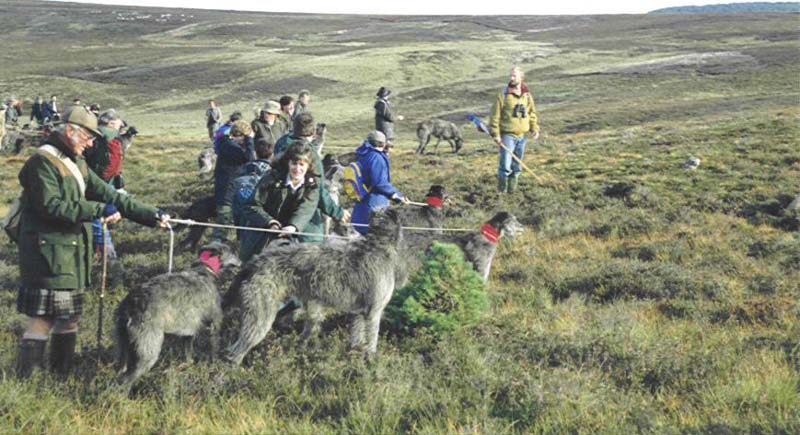 re coursing ought to provide a fun day out for a hound and owner, but if the hounds won’t treat it seriously is there any point? Perhaps if you never let your puppy see a hare or rabbit and started it really quite young for short distances, twenty or thirty yards to begin with, and gradually worked up, you might be able to train it to run a lure with real enthusiasm. However it must be said that a couple of lure courses on the smooth, flat fields necessary for its operation are no real test of stamina and agility for hounds designed to hunt the wild red deer across the rugged countryside of the Highlands of Scotland”.
re coursing ought to provide a fun day out for a hound and owner, but if the hounds won’t treat it seriously is there any point? Perhaps if you never let your puppy see a hare or rabbit and started it really quite young for short distances, twenty or thirty yards to begin with, and gradually worked up, you might be able to train it to run a lure with real enthusiasm. However it must be said that a couple of lure courses on the smooth, flat fields necessary for its operation are no real test of stamina and agility for hounds designed to hunt the wild red deer across the rugged countryside of the Highlands of Scotland”.
Cassel ’s insight is absolutely correct that the potential for Deerhounds will improve with mental conditioning on a lure from an early age. Serious physical conditioning comes later when they are approaching the age at which they can be entered to the field. His questioning their apparent lack of serious intent is perhaps relative to their own well-being.
Running in a controlled fashion is possibly an indication of their wondering what that strange object is going to do next, or an indication of their simply having some light fun – which is the point of lure coursing.
It even perhaps highlights the maxim that when some of the best lure coursing athletes have become “lure-wise” they will be penalized for their experience and anticipation.
Modern UK Deerhound coursing enthusiasts have been able to witness forty-five seasons of coursing with Deerhounds on both the blue hare and the brown. Some of that coursing is done on terrain in Scotland that can only be described as treacherous. Serious injuries, even occasionally lethal accidents can occur from fencing, rocks and depressions in the ground and steeply inclined terrain covered in heather. Their experience of countless high-speed takes of both sorts of hare informs us that the following unfortunate conclusion by Peter Lowe concerning lure coursing is seriously flawed,
“If more Scottish Deerhounds chased the lure, there would probably be a lot of broken bones. They just don’t have enough bone for all that leg. Before the Norma’s and the Nora’s descend upon me I’ll mention that I know there are exceptions. I hope that lure coursing helps the breed”.
One could be forgiven for believing the source of this strange idea to be the unfortunate experience of one man and his dog, Steve Copold and his Deerhound Gus that broke both its front legs – coursing hares, not lures – as described in “Hounds Hares & Other Creatures.”
In 1975, three years after the birth of ASFA, predating as well as contradicting Peter Lowe, he also wrote,
“I cannot in good conscience recommend Deerhounds for open field coursing, but if started as pups they can be fine dogs on the lure. Many of the older ones will show great enthusiasm. The advantage of the lure is that under new A.S.F.A. rules, the hounds are prohibited from coming in contact with the lure until the course is terminated and the lure is either stopped or moving so slowly that injuries of the aforementioned type cannot happen”.
However, in his book published two years later, Steve Copold qualified that opening sentence by deleting his negative recommendation concerning open field coursing. Since then he may well have understood that his theory though well intended, based solely on the experience of one luckless animal, was misguided. It has no relevance in general either to hare or to lure coursing Deerhounds.
Unfortunately Peter Lowe’s claim based on two incidences of Deerhounds “breaking a front leg,” according to him apparently without good cause, was sufficient for him to conclude that almost an entire breed with the exception of some bloodlines was in potential danger from lure coursing due to the prevalence of “weak fronts”. Which is ludicrous. There are very, very few knowledgeable Deerhound enthusiasts who would pretend to have this sort of clairvoyance of all the bloodlines in their own breed, let alone in any other.
The two conclusions taken together could be a compound comedy of errors, were it not for the tragedy of those that were personally involved. Consulting a number of experienced Deerhound owners that were acquainted with the true facts concerning the two different hounds, reveals one broken front leg, and a small fracture to the head of the humerus. Both of which have been attributed to falls caused by holes in the ground.
“A sport that does not catalogue and seriously investigate its injuries may well become injurious itself”.
One of the advantages of lure coursing is that due to the controlled environment, comparisons between courses and between hounds will be more significant than in live coursing, where another hare dictates every course. One disadvantage is that due to the high frequency of hounds following the same line, if there is a danger spot in a lure course it will dramatically increase the risk of the accident waiting to happen. In contrast, live coursing will experience in each and every course its own but different risks.
Rest assured, there is absolutely no evidence that Deerhounds break their legs more than any other breed when they go lure or live coursing. Broken legs may occasionally happen on a lure field. Perhaps occurring with the same rare incidence as on the human athletic field. The cause will be more than likely a combination of dangerous ground, illogical layout, lack of training and may possibly be aggravated by old stress injuries in an unfit hound.
These anecdotal events and the published comments on them are deeply regrettable. I believe they have been as counterproductive as Copold’s theory itself.
(See for example: Brown, C.M. Dog Locomotion and Gait Analysis 1986, page 41)
“Many Deerhounds, because of their short necks, dive on the hare, but such diving sometimes results in a broken front leg”.
Experience tells us that the accidents of this sort that Deerhounds may have are typically those that any sighthound breed has, and result from fast play and the live chase itself. They certainly do not happen in the controlled environment of the lure field without good cause.
When lure coursing increasingly wishes to simulate live coursing, which it cannot, you can be sure that injuries will increase.
The greatest damage incurred by lure coursing with a well-prepared and well-conditioned Deerhound is possibly to the egoism of the owner. If you wish to score in this arena, with let us say a Best In Field, then you have the wrong breed.
Most Deerhounds simply do not have the single-minded desire for the lure that the majority of Whippets appear to have.
Even then, some of the best lure racers or lure coursers can run into a glass wall, and at some time become indifferent to the lure. Over-familiarity may well breed contempt. The best reason to go lure coursing is for the rewards to the hound and your pleasure in that.
Very few people now know or can recollect that Norah Hartley herself had coursed hare competitively with Deerhounds. She retired from the sport due to her belief that it was having the wrong effect both on owners and their hounds. Hounds that were designed to catch and kill red deer , but not hares. Anastasia Noble, the other renowned breed enthusiast, puts that point of view into a broader perspective,
“Deerhound coursing cannot compare with greyhounds for speed or agility. They do not run with the same tremendous fervour and owing to their size, they turn more slowly.
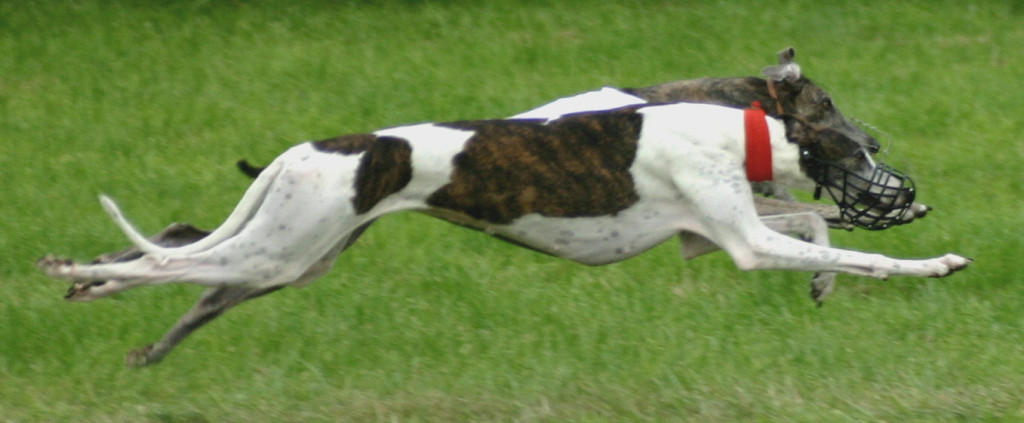 However we do not want our hounds to be hare coursers only, for which a greyhound is obviously best, nor do we want to split the breed and have coursing and show hounds, as there is not enough coursing nor is it their real work. We do it faute de mieux – because it keeps the working ability going and because they love it and so do we”.
However we do not want our hounds to be hare coursers only, for which a greyhound is obviously best, nor do we want to split the breed and have coursing and show hounds, as there is not enough coursing nor is it their real work. We do it faute de mieux – because it keeps the working ability going and because they love it and so do we”.
The principle of that argument will be used now and in the future, in defense of lure coursing.
Deerhounds both ancient and modern are not Greyhounds. They run in a different manner.
Norah Hartley quotes the 19 th century veterinarian, William Youatt, on the “Scotch greyhound”,
“He adds that this dog is used for coursing hares, but that it is apt to run sly, and in some parts of the country it is refused entry in sweepstakes for that reason”.
To which we can add the observations passed on by Youatt’s contemporary, the critical journalist “Stonehenge”, concerning the breed running differences between “Old Scotch deerhounds” and the “Scotch greyhound”, at a time when almost any major region of the UK had its own variety of Greyhound,
“N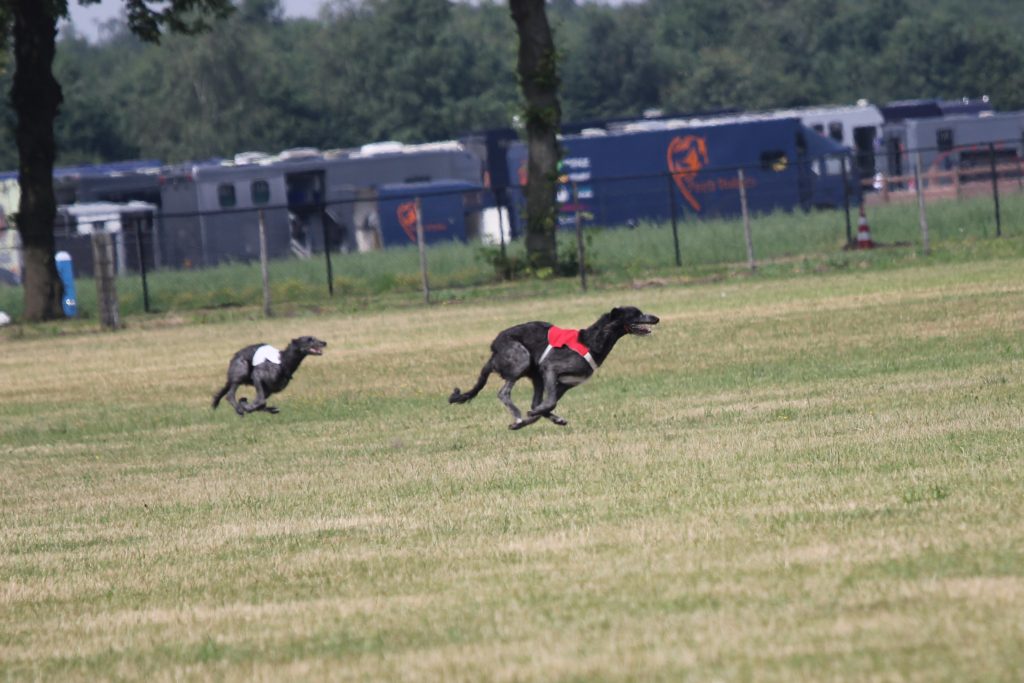 o one can say, by looking at the two breeds which is the greyhound and which is the deerhound; but the moment they are slipped, either at the hare or deer, a remarkable difference in the style of is apparent, which detects the courser of the hare from that of the deer. They are equally fast, but the deerhound gallops with his head in the air, and his body raised off the ground, ready for a spring at the throat or ear, or even the thigh of his prey; while the greyhound, with his head close to the ground, lies down ventre à terre; and he is also prepared to pick up his game, not to pull it down”.
o one can say, by looking at the two breeds which is the greyhound and which is the deerhound; but the moment they are slipped, either at the hare or deer, a remarkable difference in the style of is apparent, which detects the courser of the hare from that of the deer. They are equally fast, but the deerhound gallops with his head in the air, and his body raised off the ground, ready for a spring at the throat or ear, or even the thigh of his prey; while the greyhound, with his head close to the ground, lies down ventre à terre; and he is also prepared to pick up his game, not to pull it down”.
From the owner who has combined and critical experience of both fur and lure and given us the first valuable discussion of breed differences in running technique, Steve Copold,
“Deerhounds in full stride are a sight to behold. For their size, they are fairly agile and excellent in a wrench although somewhat slow to recover from a turn. A dedicated Deerhound can match most Salukis for distance”.
To achieve that level of dedication in the mature Deerhound, breeding and preparation are required, the courage of the owner to allow an immature hound to make mistakes from which it can learn how to protect itself, to refrain from overprotecting it, and therefore to give it the opportunity to physically and mentally develop to its maximum potential. As Barbara Heidenreich notes,
“It boils down to muscle tone, attitude, purposeful drive in the animal’s gait and a gleam in the eye, as opposed to the that sweet lap dog look which is so much a part of a Deerhound too”.
Norah Hartley advises,
“As they grow older, exercise should be gradually increased until the adult hounds are taking all that the toughest most devoted owner can find time and strength to give them”.
Finally we cannot forget just how important it is that Deerhounds were not selected to course hares, and they are of course not judged in the UK specifically on killing hares. For those field judges that penalize this breed for not shaking plastic – as if it could be killed, a quote from the breed standard,
“Neck. – The neck should be long; that is, of the length that befits the Greyhound character of the dog. An over-long neck is not necessary or desirable, for the dog is not required to stoop to his work like a Greyhound”.
Whilst live game invariably has an inescapable attraction for a young healthy sighthound, which the lure does not, it is occasionally the case that in lure coursing a cardinal principle of live coursing may well be reversed. The principle is that at the end of the chase hounds do not seriously contest the kill.
However, there is an unhappy aspect of the lure that can breed envy, the will for possession, especially when it is stationary at the end of a heated follow. This can lead to mutual aggression. Individuals of any breed that show hostility on the lure can become a serious flaw in the sport.
Every owner has the responsibility to ensure that his hound is trained to run cleanly. So that it will not terminate the running career of any other participant. Dominant or aggressive behavior before, during and after the course must be seriously discouraged as it can have a devastating effect on other dogs. It is rare for Deerhounds to interfere, or intimidate by this sort of one-upmanship, but it can happen. If you are unfortunate enough to own such a dog then withdraw it from competition. Run it solo where the training possibility exists. Running it with a muzzle on only increases the general tolerance of bad behavior on the field.
As Lyle Gillette stressed when interviewed by Pat Gail Burnham,
“Another thing lure coursing meant was that we could weed out the poor dispositions because we would not let them run with muzzles. If they had to run with muzzles, then go on home. If a dog was so bad that he had to be muzzled to run, I didn’t want him running!”
The received opinion that you can contain or cure this sort of behavior by muzzling is every bit as misguided as the suggestion that you can beat it out of a dog. You will know how your dog reacts with other dogs, and if you have good reason to expect it will cause a rumble on the field, stay away. If, on the other hand, you have the conviction that your hound is going to be victimized, for example by a growling competitor at the start, do not slip him. If you see it happening during the run, pick him up as soon as you can. You may not be the most popular person on the field, but you will have the satisfaction that you have aided your hound, prevented worse and given an unmistakable signal to the indifferent owner of a delinquent.
Judges, coursing and breed clubs, but especially owners, who do not accept their own specific responsibility in retiring aggression from the field do any breed an injustice, and this breed in particular due to its justly renowned good disposition.
“Speed, endurance, courage, strength and weight, the requisite coursing qualities”.
Wrote Lord Colonsay a century and half ago, as quoted by Norah Hartley. He was the Deerhound conservationist and coursing enthusiast pur sang. Desire was taken for granted. Today, lure coursing has for obvious reasons nothing to say about courage and strength, and very little on endurance. It has all the more to say about desire, a quality without which the sport does not exist.
There are ten guiding rules that have been distilled from years of experience in preparing sighthounds for the track and field in Europe. They are doubtless well known to any North American insider. They are mainly concerned with training or breeding that same quality, desire for the lure.
Always remember that force will never achieve anything.
Acclimatize your pup for short periods to the environment and the activity of a lure trial or training session
while doing so constantly encourage and reward its self assurance.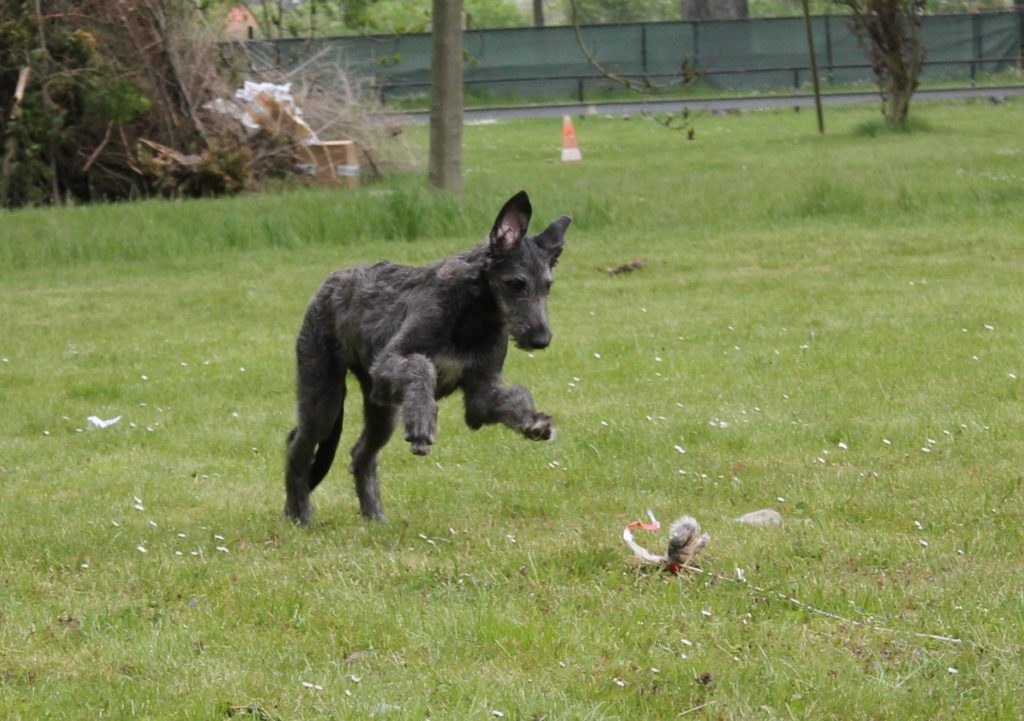
Begin running with short distances following the lure, initially without any pulleys, and build the distance up gradually from 20 to 50 to 100 yards.
In doing so always give your hound the chance to reward itself by taking the lure at the end of its follow.
Err on the cautious side. Only let a hound run a complete layout from the age of between 9-12 months, depending upon the capability and condition of the individual.
Make sure that your hound is absolutely steadfast and singleminded on the lure before you ever let it run with another hound.
Avoid allowing hounds to play with a lure together, it may encourage aggression.
If a plastic lure will not attract your pup exchange it for something more natural such as a rabbit skin.
Only ever allow your hound to run during a training session or a trial, if it is physically and mentally fit.
Start your pup as soon as it is well and truly acclimatized at home by encouraging it to playfully follow a fluffy toy or old sock on a short string. If you have a number of pups, avoid running them as a pack; you may well be reinforcing dominance and submission in the group. Encourage its enthusiasm and desire for its ‘lure’, but only for seconds at a time so as to avoid boredom and physical strain. Dedicate this toy to those occasional exciting treats only. Slowly, over the months, progress to a longer string, and then connect that to a lunge pole. Do not rush things, always reward your hound, and allow it to reward itself.
Only after it has become really well lure trained on the field at say 9 months or more, then try it with a safe and experienced dog that you know will not dispute the lure with your pup, do it again, then again, and then once more; but no more than once on the same day. A couple of runs only are no significant proof. Avoid the temptation to train it by letting it follow another hound, you may well be encouraging playful interference or much worse.
A De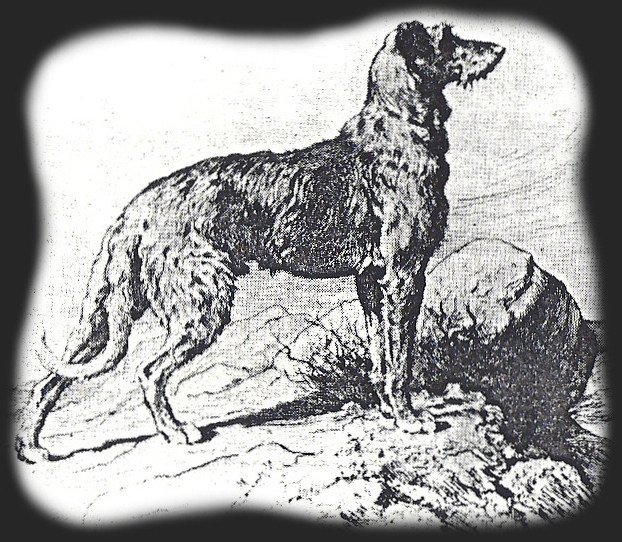 erhound had but a few minutes to take a deer by its own superior speed, agility and strength. Three to four at most, otherwise it would have gone well over its anaerobic threshold and been too slow and tired to do the job properly. The average course duration of modern Deerhounds on hare in the UK,as quoted by Stable and Stuttard, is between 60 and 90 seconds. Lure coursing in many ways reflects the endgame of a run on a hare. It is for that sort of strenuous agile sprint that they should be physically trained and prepared, in mutual play, out exercising along with their owner doing interval training, walking, jogging, running and cycling; in straight and oval racing both of which are excellent sprint and lure training, and of course in lure coursing itself.
erhound had but a few minutes to take a deer by its own superior speed, agility and strength. Three to four at most, otherwise it would have gone well over its anaerobic threshold and been too slow and tired to do the job properly. The average course duration of modern Deerhounds on hare in the UK,as quoted by Stable and Stuttard, is between 60 and 90 seconds. Lure coursing in many ways reflects the endgame of a run on a hare. It is for that sort of strenuous agile sprint that they should be physically trained and prepared, in mutual play, out exercising along with their owner doing interval training, walking, jogging, running and cycling; in straight and oval racing both of which are excellent sprint and lure training, and of course in lure coursing itself.
References;
Patricia Gail Burnham: An interview with Lyle & Phydelma Gilette ‘Rancho Gabriel’ Sighthound Review November/December 1992
Kenneth Cassels: A Most Perfect Creature of Heaven – The Scottish Deerhound 1997
Steve Copold: Running Techniques and Movement in the Sighthound Breeds as Related to
Open Field Coursing The Gazehound July/August 1975
Steve Copold: Hounds Hares & Other Creatures: The Complete Book of Coursing 1977
Norah Hartley: The Deerhound 1972
Barbara Heidenreich: Deerhounds and Exercise, in Your Scottish Deerhound Primer 1989
Q. van Hummel: The Scotch Deerhound, in The American Book of the Dog. G.O. Shields 1891
Peter Lowe: FAN Interview Field Advisory News January/February 1992
Anastasia Noble: Deerhounds, in Coursing – The Pursuit of Game with Gazehounds R. Grant-Rennick 1976
Owen Stable Q. C. & R. M. Stuttard: A Review of Coursing 1971
“ Stonehenge ”: British Rural Sports 1877
As a post script it is interesting to note that Steve Copold also published an article, “Foreleg fractures in the Scottish Deerhound” in the SDCA’s Deerhound Newsletter of the May-June 1975, and that both the editor Cecilia Arnold, and Anastasia Noble, were in their response to quote the same paragraph from the breed standard concerning “the neck” of the Deerhound.
Steve received no support for his hypothesis from the pages of the Deerhound Newsletter nor its successor The Claymore. Some readers such as Florence Atkinson did voice their fear of coursing injuries in general, some readers such as John Wiley and Gerri Akman took exception and condemned his idea. Gerri remarked, “I’ve heard that he has since retracted this theory.”
The most telling voice of experience was that of Anastasia Noble who wrote in the Newsletter of November-December 1975, at that time after some 20 years of competitive hare coursing in the UK, explaining that Steve was wrong and that he had been exceptionally unlucky with the particular hound he had run (which was ‘J-Mar’s Gus of Ardkinglas” – not itself from the Ardkinglas kennel).
Unfortunately Steve did not address Anastasia’s arguments, but persisted with his theory and put it into print in book form in 1977. That was the same year in which he wrote to The Claymore of May-June, that
“He (Gus) is, by my own admission, one of the poorest physical specimens of the breed I have ever seen, yet he managed to pull down three deer”.
That Steve once again included his theory unrevised in his new edition of “The Complete Book of Coursing” in 1996 was not I believe due to any conviction of his on the matter, but more likely due to apathy. Which is unfortunate, as there is so much of real value in that work.
Peter Lowe was given the chance to defend or rectify his opinion but declined, stating with reference to his quote in the original FAN interview of 1992,
“My comments were colored by seeing a couple of incidences in which deerhounds broke their front legs while running on perfectly flat terrain, and apparently without taking a big fall. It was amplified by discussions with one breeder who told me that the breed does have a problem with very weak fronts. That was the extent of my knowledge at the time I made the comment. I know there are bloodlines for which these comments should not apply”.
Alas he would not name “the breeder”, and we cannot fail to be unimpressed by his knowledge of a breed, which he does not own nor apparently know well, especially considering his remark in that same interview concerning his own breed,
“When I was more inexperienced than I am now, I thought I could look at a Saluki and judge his conformation and relate this to his running ability. I have been proven wrong so many times, that I do not make these claims any more”.
Richard Hawkins
The original version of this article appeared in the ASFA Field Advisory News (3) Sept/Oct 1999.